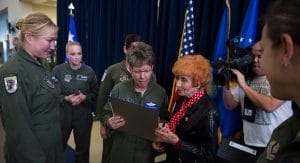Born in Los Angeles, Otto needed to go to work to take care of her mother and son. It was 1942, and she became a “Rosie the Riveter” (“an allegorical cultural icon in the United States who represents the women who worked in factories and shipyards during World War II. She is widely recognized in the ‘We Can Do It!’ poster as a symbol of American feminism and women’s economic advantage.” —Wikipedia). She worked at Rohr Aircraft Corp. in Chula Vista, Calif. No one would rent her an apartment because she had a kid, so she had to pay someone to board him during the work week. “It cost $20 a week, and it was hard because I made 65 cents an hour,” she said. Her job: building — yes, literally riveting — military aircraft. Once the war was over, the workers were all fired. “They needed us at one time, and when the war was over, they let us go,” she said decades later. “That’s how it was.”

Otto tried office work, but hated sitting still, so she found another job, at Ryan Aeronautical Co. in San Diego. After 14 years, she was laid off again. A year later, she heard Douglas Aircraft was hiring assembly workers in Long Beach. She raced up there to apply, and was hired. During her tenure Douglas merged with McDonnell Aircraft to become McDonnell Douglas, which was later absorbed by Boeing. During that time she worked on every Boeing C-17 Globemaster III cargo plane the company made and, after the last of that series passed through the line at the end of 2014, she was laid off again. Quite the waste, considering she was only 95 years old. Still, a year before, a co-worker warned a reporter writing about her as she worked, “Don’t get in her way, she’ll run you over.” The co-worker was serious.
On and off — mostly on — Otto worked in airplane manufacturing in southern California for 72 years. “I’m a working person, I guess. I like to work. I like to be around people that work,” she said. “I like to get up, get out of the house, get something accomplished during the day.” After leaving Boeing, she just shrugged off her contribution as just a job. “You’ve saved American lives and you’ve been saving American lives your whole life,” John Perry told her. Otto is his grandmother. He said as a boy, when he wrote her letters, Otto would correct his spelling and grammar with a red pen and send them back to him with her replies.

When the women who worked in the war effort became more appreciated in the early 21st century, Otto, as one of the original and longest-working “Rosies”, received more and more recognition; Otto finally was given a ride in a C-17 by the U.S. Air Force in 2017. She rode in the 2014 Veterans Day Parade in New York City, and appeared on The Ellen DeGeneres Show and The Today Show to tell her story. “Women have thanked me for us paving the way,” she said, clearly awed. And she was ready to go back to work. “When I go to heaven,” she laughed, “I hope God keeps me busy.” She died in a hospital in Las Vegas, Nev., on November 12 after a stroke. She was 104.
— — —
Author’s Note: See also Honorary Unsubscribes for Rosalind Walter (2020, who provided the name) and Naomi Parker Fraley (2018, who inspired the iconic “We Can Do It!” image).
